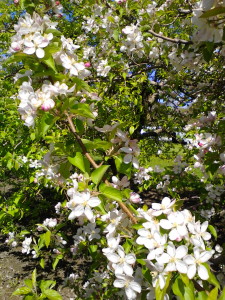 Right on schedule, the orchard is in full bloom this week. Typically, the third week of April, usually around the 25th of the month, the orchard bursts with fruit blossoms. Beautiful, beautiful, beautiful is the only way to describe it. The first variety to bloom this year was the Anoka, followed by the Zestar. By midweek we saw blossoms on the Honeycrisp, Gala, Cortland and McIntosh. By week’s end all varieties were “strutting their stuff.”
Right on schedule, the orchard is in full bloom this week. Typically, the third week of April, usually around the 25th of the month, the orchard bursts with fruit blossoms. Beautiful, beautiful, beautiful is the only way to describe it. The first variety to bloom this year was the Anoka, followed by the Zestar. By midweek we saw blossoms on the Honeycrisp, Gala, Cortland and McIntosh. By week’s end all varieties were “strutting their stuff.”
We had several hives of honey bees brought into the orchard to assist those already in permanent residence in helping with the pollination. Although the bees are busy doing their work for the hives, they are inadvertently helping pollinate the apples by flying from bloom to bloom and tree to tree. Pollination days were not the best this year. Cooler temperatures with overcast skies discouraged the honey bees from leaving their hives to collect pollen and nectar. When the temperatures did get warmer, rain showers moved into the area further hampering the efforts of the bees. 
The constant concern of the orchardist during and after the bloom period is freezing temperatures and frost. At bloom we usually hope for warm nights and keep our fingers crossed. When fruit bud is affected by the cold temperatures and is destroyed, it is gone for the season. No new fruit bud regenerates. This past week there were two nights of cold and dipping temperatures below 30 degrees. One of those nights the lower orchard was 29 degrees with heavy frost and there has been some damage to the fruit bud. We have been taking initial assessments but hard to make any definite determinations at this time. Small orchardists have a hard time to ward off these challenges created by Mother Nature in the Spring. We are somewhat at a disadvantage because we do not have the resources to invest in some of the equipment that offers frost protection. Anyone growing fruit in the Midwest is aware of the fact that every year presents different challenges and it’s always a gamble and never a guarantee.
